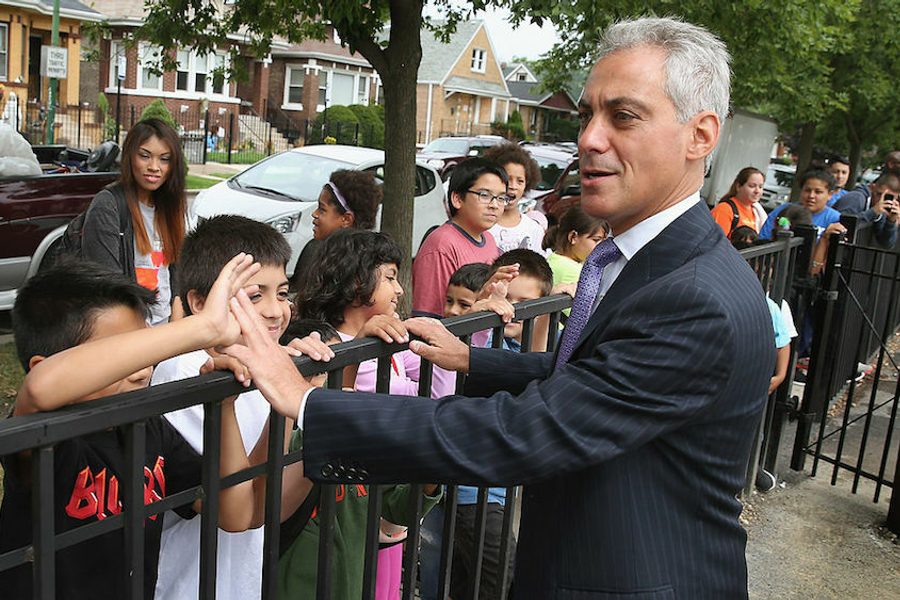Why “Pay for Success” Financing Could Cost Taxpayers More Than They Bargained For
Cash-strapped governments are increasingly turning to Wall Street to fund social services. Will the model be a Trojan horse for privatization?
Rachel M. Cohen

With looming pension payments and a budget deficit of $129 milllion, the Chicago Public Schools (CPS) is in financial turmoil. Earlier this spring, Mayor Rahm Emanuel even hinted that CPS might be forced to end the school year three weeks early to save money.
Yet despite these financial woes, Chicago’s school district recently agreed to pay more than a million dollars to Goldman Sachs and other investors that fronted funds for an early childhood education program, part of a social experiment known as “Pay for Success.”
Under Pay for Success, described as an “innovative financing structure,” private investors such as banks and foundations put up money for social programs with measurable outcomes — for example, reducing chronic homelessness by 200 individuals per year. If the predetermined goals are met, the government will pay the investors back with interest.
Chicago’s Pay for Success project launched in 2014, and aims to improve students’ kindergarten readiness, boost third grade literacy and reduce special education services. Goldman Sachs, Northern Trust and the Pritzker Family Foundation invested $16.9 million into the program, with the potential to roughly double their investment over the next 18 years. The bulk of those returns would come from reducing special education services for the 2,600 program participants — about $9,100 per child.
Undergirded by narratives of wasteful government spending and market-driven accountability, a small group of philanthropists, financiers, and policy leaders have helped elevate the Pay for Success model quickly over the past few years. State and local governments have launched 16 such projects across the U.S since 2012, tackling a range of issues from foster care and education, to criminal justice and public health. Dozens more wait in the pipeline.
At its best, advocates say that Pay for Success could foster greater government accountability, fund needed programs in cash-strapped political climates and potentially save the public money down the line. “Innovative models like Pay for Success … shift the risk of achieving targeted outcomes away from the taxpayer and enabl[e] governments to pay only for what works,” said Andrea Phillips, the Vice President of Goldman Sachs’ Urban Investment Group.
But at its worst, Pay for Success can leave taxpayers paying substantially more than if their governments had just funded programs directly, cement narratives of fiscal austerity and incentivize misguided social outcomes.
The Trump administration has yet to embrace Pay for Success by name, and cut funding for a significant Obama-era program that promoted the model. Yet the underlying goals of Pay for Success — expanding public-private partnerships to tackle societal ills — fit comfortably with the new administration’s stated priorities. Though some supporters have expressed concerns about Pay for Success’s future under Donald Trump, there’s strong evidence to suggest it will continue to grow over the next four years, especially in the realm of education.
The roots of a new model
In 2010, the first Pay for Success project launched in the United Kingdom, a six-year pilot aimed to reduce recidivism from a prison in Peterborough. It was funded by “social impact bonds” and promoted by Social Finance UK, a group that had formed three years prior by Ronald Cohen, a man dubbed “the father of British venture capital.” Social Finance UK helped raise the upfront £5 million, mostly from the philanthropic sector. (The Rockefeller Foundation was the only U.S. institution to invest.)
Enthusiasm for and deep faith in Pay for Success’s innovative potential spread quickly across the Atlantic Ocean, long before the results of the Peterborough pilot were in.
Some U.S. groups were already organizing. New Profit — a “venture philanthropy fund” with a board that boasts Bain Capital executives and other investment leaders — launched an advocacy arm in 2007, innocuously named America Forward. When Barack Obama was elected president in 2008, the group recommended that his transition team establish a “social innovation fund.”
The Obama administration ran with the idea, and in early 2009 established the first-ever Social Innovation Fund, administered by the Corporation for National and Community Service, and the first-ever White House Office of Social Innovation—both of which mobilize private-sector partnerships and Pay for Success projects. Sonal Shah, an alum of both Goldman Sachs and Google, came on board to lead the new executive office.
“We’re very lucky that this [Pay for Success] concept really resonated with the White House, and Sonal Shah, she quickly saw that this tool combined many things that the Office of Social Innovation was trying to do,” says Tracy Palandjian, the CEO and founder of Social Finance, the U.S. sister organization to Social Finance UK. Shah, who left Obama’s administration in 2011, is now an emeritus board member of Social Finance.
In its short existence, Pay for Success has been championed by a small, interlocking group of actors within the Obama administration, financial institutions, advocacy groups and research institutes. Meanwhile, three foundations have played particularly significant roles: the Rockefeller Foundation, Bloomberg Philanthropies, and the Laura and John Arnold Foundation. In 2015, the Laura and John Arnold Foundation gave $8.4 million to the Urban Institute to launch an effort dedicated to advancing Pay for Success projects across the country. By 2014, the Rockefeller Foundation had spent nearly $10 million getting Pay For Success off the ground, from facilitating meetings with PFS supporters and the White House, to funding Center for American Progress promotional materials. And all three foundations have funded the Government Performance Lab at Harvard, established in 2011, that helps implement and expand Pay for Success initiatives. Jeffrey Liebman, who served in the Obama administration as the deputy director for policy at the OMB, runs the Harvard center.
Federal support for Pay for Success continued to mount steadily under the Obama administration. In 2015, Congress passed the Every Students Succeeds Act (ESSA) — the successor to No Child Left Behind — and changed the law to allow states and school districts to use federal dollars to fund Pay for Success projects. The move was applauded by groups excited about leveraging public money with private partners, and criticized by others for the same reason. Senator Orrin Hatch, (R-UT), largely responsible for the inclusion of Pay for Success in ESSA, said “rather than being limited by what federal bureaucrats at the Department of Education think best, funding should be more connected to local innovation and successful outcomes.”
Lexi Barrett, a former policy advisor in Obama’s DOE who also served on his Domestic Policy Council, left the executive branch in 2014 to work as the policy director for America Forward, where she pushed for Pay for Success’s inclusion in ESSA. Now she works as the director of National Education Policy at Jobs for the Future, which was recently awarded $2 million in Department of Education grants to spearhead Pay for Success projects in career and technical education.
“The fact is you have very senior level officials leave the federal government and then turn around to lobby and influence their former agencies,” says Craig Holman, the government affairs lobbyist at Public Citizen, which advocates for tougher restrictions on former federal employees.
The Obama administration laid the groundwork for Pay for Success, paving the way for its potential expansion under Trump — who has declared his intent to expand public-private partnerships across all sectors of government.
A bipartisan commission established last March by Speaker Paul Ryan (R-WI) and Senator Patty Murray (D-WA) will be issuing formal recommendations later this fall on how to grow the evidence-based policy movement. America Forward lobbied for this federal commission, and Jeffrey Liebman serves on it. And a bipartisan bill — the Social Impact Partnership to Pay for Results Act — was reintroduced this past January, which would direct at least $100 million to states and local communities to expand Pay for Success projects.
Meanwhile, in March, Trump announced the creation of the White House Office of American Innovation, charged with improving government and society in collaboration with the “private sector and other thought leaders.” With its stated plans to tackle areas like workforce development and the opioid crisis, PFS supporters have been eyeing the Office of American Innovation as a potential new base of federal support. Senior White House advisers, including Goldman Sachs alumni Gary Cohn and Dina Powell, were even tapped to help guide the new agency. Before joining the Trump administration Powell herself had led Goldman’s “impact investing” initiatives, a portfolio that includes Pay for Success.
Differing definitions of “success”
With its inclusion in ESSA and its relatively strong DOE support, investors, nonprofits, and policymakers have identified real potential for using Pay for Success in education.
Last September, Senators Hatch and Michael Bennet (D-CO) introduced legislation that would encourage schools to use Pay for Success to expand career and technical education. The two legislators introduced another bill this month to include Pay for Success initiatives within the Higher Education Act, so that PFS could fund interventions around things like increasing college completion for low-income students.
Moreover, this past December, the federal education department awarded more than $3 million to eight government organizations to launch Pay for Success feasibility studies in early childhood education. The winners include the state of Minnesota, a charter school in South Carolina, a school district in California, and five local government agencies. The goal, the DOE said, will be to assess each program’s design with a “cost-benefit analysis showing the return on investment to the community.”
Yet despite the enthusiasm, there are reasons for wary. So far, just two Pay for Success preschool programs have launched, neither of which could yet credibly be called successful.
One was an early childhood education program in Utah, which was initially reported to help 99 percent of students in its first cohort avoid special education services. Goldman Sachs fronted $4.6 million for the project, and took home its first payment of $267,000 in 2015 for supposedly reducing the number of children who would have otherwise needed special education. But experts later questioned the program’s high success rate, and criticized its evaluation metrics for being designed in a way that could dramatically overstate the program’s impacts.
Specifically, a number of early education experts noted in The New York Times that the Utah program had far less funding than that of other high-quality programs, and those better-funded models generally see success rates of around 10 to 20 percent — not 99. Utah’s high rate was premised on an unfounded assumption that every child would need special education without the preschool intervention, yet there was little evidence to suggest that was true. Nevertheless, Pay for Success advocates — including Obama White House officials and DOE leaders — continued to point to Utah as evidence that the PFS model “works” and should be replicated.
The other ongoing PFS education project is Chicago’s, which has sparked opposition for using such an expensive financing tool — particularly amidst a local fiscal crisis — for such a non-risky investment. Critics note that Chicago’s PFS preschool model, Child Parent Centers, has boasted positive results for decades, and is well known to deliver improvements in student performance. The mayor’s office justified the Pay for Success investment by saying today’s students are Hispanic, whereas much of the earlier research was done with black students.
“It’s not a high-risk program for the investors because they have all these metrics and studies that show these programs have a positive impact on the measures they’re going to use to measure success,” Pavlyn Jankov, a researcher with the Chicago Teachers Union, told The Chicago Reporter in 2016. “They wanted to declare success a year from now and propel [social impact bonds] across other education endeavors. It’s very prescient, as investors know public education is struggling for funding.”
In 2016, Chicago’s program yielded an initial kindergarten readiness “success payment” of $500,000, and last month evaluators reported another $500,000 payment for the second cohort. Evaluators also recently reported an initial $17,597 payout for reduced special education services — a figure lower than investors anticipated.
But is reducing special education services a success?
“I’ve spent my entire career working on improving special education services, and school districts continually look for ways to not have to provide them because it’s expensive,” says Bev Johns, president of the Learning Disabilities Association of Illinois, who has been a vocal Pay for Success critic.
Denise Marshall, executive director of the Council of Parent Attorneys and Advocates, which fights to protect students with disabilities, says their members first started raising alarm when they heard Pay for Success was to be included in ESSA. They worry such projects can run afoul, or compete with federal special education law and civil rights law — specifically the “Child Find” under the Individuals with Disabilities Education Act, which obligates schools to identify and evaluate students who lag behind, and provide them with needed services.
“Incentivizing reduced referrals flies in the face of that [federal] obligation,” says Marshall. “Being placed in, or becoming eligible for special education services is not something that should be frowned upon, or looked at as a social problem.”
Their concerns were exacerbated by Donald Trump’s appointment of Betsy DeVos as education secretary, who demonstrated shocking unfamiliarity with the Individuals with Disabilities Education Act during her Senate confirmation hearing.
Nicole Truhe of America Forward defends using Pay for Success in education, and says they’re working on establishing “appropriate guardrails” to protect students with disabilities. The Department of Education also says they will require “proper safeguards” for the projects. Of the eight early childhood education pilots recently awarded federal grants, three included reductions in special education services as a rewardable outcome measure.
Some in the Pay for Success orbit are optimistic that the field will continually improve with more evidence and rigorous evaluation — ideally experimental models known as ‘randomized control trials’ — but others, like those at Social Finance, put less stock on research evaluations, and urge leaders to focus primarily on results.
While Obama’s administration catapulted Pay for Success onto the national stage, the public-private model is likely to grow under Republican control. Supporters are quick to say that PFS is just “one tool in the toolbox” to advance social programs — yet there’s good reason to think it could become an awfully popular tool in the coming years. After all, with conservative themes of using the private sector to hold governments accountable, and with its invitation to enrich the rich further if they can advance some sort of social good — well, banks are likely to deem that deal quite a success.
This reporting was supported by the Leonard C. Goodman Institute for Investigative Reporting.







